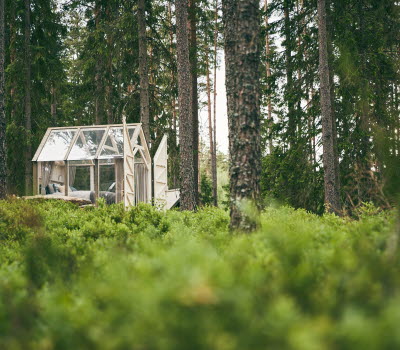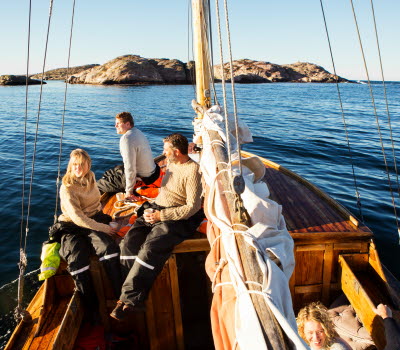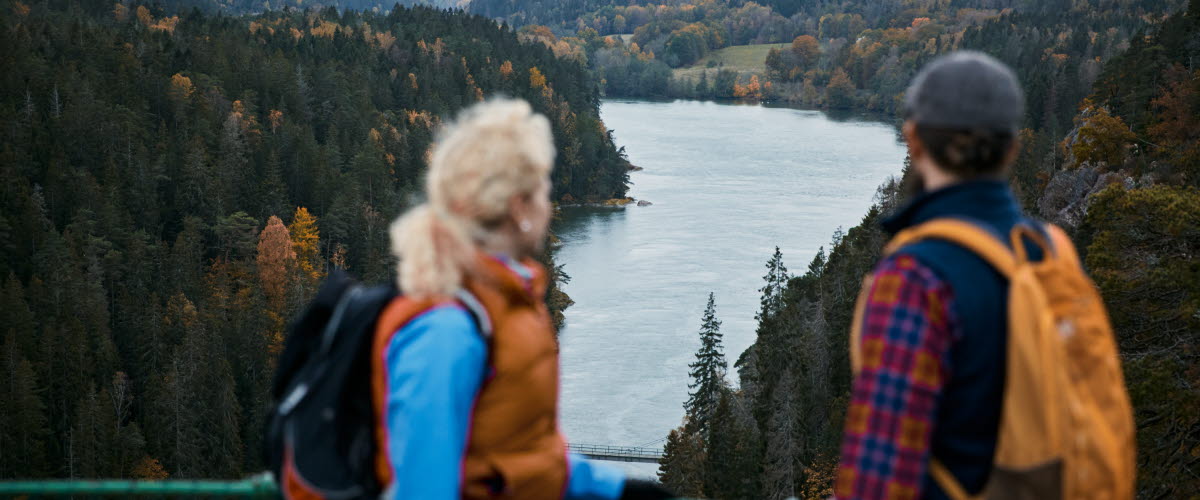Pilgrim Path Göta älv – A scenic and historical hiking trail
The Pilgrim Path Göta älv is one of Sweden’s most fascinating hiking trails. It’s packed with historical landmarks, amongst river valley scenery offering iconic nature experiences. The whole trail is 130 km long and stretches from the centre of Gothenburg to Vänersborg.
Facts about the trail
Length: Approximately 130 km, divided into 10 stages.
Timing: The stages are suitable for half or whole day walks depending on your pace. If you want to walk the whole route you’ll need around 7 to 8 days.
Difficulty: Mostly moderate. Some stages are easy and others require a better fitness level.
Terrain: Very varied. The Pilgrim Path goes in parts through countryside, forests and on small paths. It also leads from church to church which means some stretches are near urban areas on asphalted cycle paths and gravelled roads. You’ll need good walking boots in some parts.
Waymarking: Pilgrim bands and pilgrim signs
Clothes and equipment: On some stages you’ll need good walking shoes, rucksack with picnic, water bottle and clothes suitable for the weather. If walking longer than one day you’ll need a change of clothes and accommodation plans.
Insta-moments: As well as all the beautiful churches, you’ll pass many photo-friendly viewpoints along the trail.
Welcome to a hiking trail that has it all. Varied scenery with many beautiful viewpoints, places to eat and stay nearby and exciting historic landmarks in the form of medieval churches, museums, mills, stone bridges and even a Buddhist temple. Keep reading to get tips for 10 places you really shouldn’t miss along the trail.
It’s easy to vary your hiking routes, either by doing shorter day trips or multi-day walks along several stages. And you can conveniently get to several suitable starting points by public transport.
Photographer: Jonas Ingman
10 sights you shouldn’t miss along the Pilgrim Path Göta älv
1. The churches
The Pilgrim Path Göta älv is in many ways a spiritual trail, and many people, whether they are religious or not, go on pilgrimages just to de-stress and get new insights into themselves. This spirituality can be felt not least through all the churches found along the way.
In Gothenburg alone you’ll pass by several churches, including Masthuggs Church, Haga Church, the Cathedral and the German Church. Don’t miss the churches in Nylöse, Kilanda, Skepplanda with its Iron Age burial ground, Lödöse, Lilla Edet, Hjärtum, Trollhättan and Vänersborg either.
Take the opportunity to go into the churches and sit for a moment on one of the pews. Maybe you’d like to light a candle and let your thoughts wander for a few minutes. Reflection is part of being a pilgrim. If you want you can take (or print from the website) a Pilgrim Passport and collect stamps from all the churches you visit.
Photographer: Jonas Ingman
2. “Mini Amazon”
The beautiful Lärjeån valley is a stretch well worth visiting, with an exciting hike along a narrow ravine edged with a jungle like deciduous forest that makes you feel as if you’re in the Amazon rainforest. And if you can say that nature in the valley is dominated by South American influences, there is also an obvious Asian element, because on the north side of the river there is in fact a Buddhist temple. Along the river you’ll also pass several bridges and a little waterfall with a salmon ladder. The Lärjeån valley can be found along stage 2.
Photographer: Amplifyphoto/ Markus Holm
3. The hub at Lödöse
There’s no doubting that this is a true pilgrim path. The whole area is permeated with pilgrim history and the town of Lödöse is one of Sweden’s biggest find areas for pilgrim badges, which you’ll see if you visit Lödöse Museum.
It's maybe hard to imagine, looking at Lödöse today, but the town was once one of Sweden’s largest and the only Swedish harbour facing west. During the middle ages Hansa ships travelled up the river and as a natural consequence Lödöse became a centre for many pilgrims. Nowadays you can continue your pilgrimage from Lödöse in more or less every direction. It’s a real hub in other words. Lödöse is found at the end of stage 6.
Photographer: Amplifyphoto/ Markus Holm
Our tip – go on a group hike!
A nice way to be part of the pilgrim story is to walk with others. On the Pilgrim Path’s website you can see which group walks are happening and when.
4. The falls and lock area in Trollhättan
If you want to experience the Göta älv river when it’s at its most dramatic you should head to the falls and lock area in Trollhättan. The spectacular ravines have attracted fascinated visitors for many hundreds of years. Keep an eye out for when the sluice gates are due to be opened, for its then, when the frothing water rushes through the ravines, that you really get to appreciate the true power of the river. You’ll pass the Trollhättan falls on stage 9.
Photographer: Joachim Nywall
5. The view points
There are lots of scenic views along the Pilgrim Path. Here are three of the most iconic:
Masthuggs Church in Gothenburg. This church, which was consecrated at the beginning of the 20th century, is in an elevated position with one of Gothenburg's best views. Up here at the top of Stigberget is also where the Pilgrim Path starts, stage 1.
Storeberg in Gamlestaden. On this hill between Nylöse church and Kviberg churchyard there’s a viewpoint that not at lot of people know about. You get a great view of Gothenburg from up there. Stage 2.
Spetalsbergen north of Lödöse, where Lödöse Museum is located. The hill has several lovely viewpoints. You can among other things see the mighty Göta älv river glittering below.
Photographer: Amplifyphoto/ Markus Holm
6. Vättlefjäll
Many who come to Vättlefjäll are surprised that such wild and varied nature exists so close to the city. This beautiful nature reserve is full of lakes with little forested islands. The area is popular with canoeists as well as hikers. You’ll find Vättlefjäll on stage 3 of the Pilgrim Path.
Photographer: Josefine JoJo Larsson
7. The ship rock carvings on Stugåsberget
On a vertical rock face on Stugåsberget in Skepplanda you’ll find an impressive rock carving of a giant ship. The ship is around three metres long which makes it one of West Sweden’s largest rock carvings. It’s also unusual to see rock carvings on vertical rock faces like this. You’ll find it on stage 5, just before you get to Skepplanda.
Photographer: Ronja Wigertz Lightray Productions
8. Bohus Fortress
If you’re keen to explore more historic places we recommend a detour to the Bohus Fortress in Kungälv. This magnificent fortress was built back in the 1300s and its walls hide many fascinating stories of kings, saints, power struggles, traitors and prisoners. You can get here by taking a 2 kilometre detour between stages 3 & 4, when you get to Jennylund.
Photographer: Ronja Wigertz Lightray Productions
9. Stay in a tree tent above ground
If you want to get even closer to nature on your hike we recommend a stay in a unique tree tent strung up between the trees. It’s like a combination of a classic tent and hammock, so you sleep a few metres above ground and can enjoy the view of the starry night sky on the other side of your mosquito proof canvas. It’s an exciting nature experience! Book a tree tent with Pevon Ecoturism.
10. Göta Älv valley
Since time immemorial the Göta älv has been an important route for travelling merchants. In fact the beautiful countryside edging the river has been inhabited for over 7000 years, and has a unique cultural heritage to explore. Hike past old burial grounds, rock carvings, stone circles, glassworks, gallows sites, and discover the many stories (and myths) about the wars between Norway, Denmark and Sweden. You can find out about the history of the Göta Älv valley along the whole route.
Photographer: Ronja Wigertz Lightray Productions
Visit the hiking page for more great hiking tips in West Sweden
Facts about the trail
Length: Approximately 130 km, divided into 10 stages.
Timing: The stages are suitable for half or whole day walks depending on your pace. If you want to walk the whole route you’ll need around 7 to 8 days.
Difficulty: Mostly moderate. Some stages are easy and others require a better fitness level.
Terrain: Very varied. The Pilgrim Path goes in parts through countryside, forests and on small paths. It also leads from church to church which means some stretches are near urban areas on asphalted cycle paths and gravelled roads. You’ll need good walking boots in some parts.
Waymarking: Pilgrim bands and pilgrim signs
Clothes and equipment: On some stages you’ll need good walking shoes, rucksack with picnic, water bottle and clothes suitable for the weather. If walking longer than one day you’ll need a change of clothes and accommodation plans.
Insta-moments: As well as all the beautiful churches, you’ll pass many photo-friendly viewpoints along the trail.














